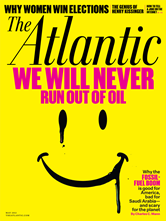ANAR Foundation and Grey create child abuse ads with hidden messages for children only. Clever way of reaching your target audience.
ANAR Foundation and Grey create child abuse ads with hidden messages for children only. Clever way of reaching your target audience.
The power of infographics and video to tell a story. We could do a video that illustrates the demand for energy around the world. How much is required and where it comes from. Maybe a series of informative videos.
Maybe there’s a lesson here about a fresh use of digital. Maybe there’s a lesson about taking a small idea and scaling it up on the web. Or maybe the people’s reactions are just priceless.
 Charles Mann’s complex, dark story about energy in the 21st century asks what will happen if carbon-based energy becomes renewable. This is a scientific and technical question that helps us understand more about the geological reality of the world. But the very subject raises a whole set of political questions. In light of global warming, should we be using fossil fuels at all? How should we account for their externalized costs? Could we develop the political will to keep fossil fuels in the ground? Are cleaner alternatives available for countries building most of the world’s new infrastructure? To address these issues, we invited experts in environmental science, energy and foreign affairs to debate the Mann story. Read more.
Charles Mann’s complex, dark story about energy in the 21st century asks what will happen if carbon-based energy becomes renewable. This is a scientific and technical question that helps us understand more about the geological reality of the world. But the very subject raises a whole set of political questions. In light of global warming, should we be using fossil fuels at all? How should we account for their externalized costs? Could we develop the political will to keep fossil fuels in the ground? Are cleaner alternatives available for countries building most of the world’s new infrastructure? To address these issues, we invited experts in environmental science, energy and foreign affairs to debate the Mann story. Read more.
Damn it, it’s starting to rain! Where’s the nearest IBM ad?
Ogilvy’s new out-of-home work for IBM is incredibly sharp as it transcends traditional advertising to become a part of city infrastructure. These super-ads can shield passersby from a heavy downpour, serve as a bench, or act as a ramp up a couple of steps. A simple curve was all it took to make this a truly interactive experience. I can’t imagine a more ideal alignment with the strategy of IBM’s ‘People for Smarter Cities’ project.
http://www.nara.me/partial/video_welcome.html
if Yelp and Pandora had an offspring…
check it out at nara.me
By and large, advertisers are missing the boat when it comes to using digital ads for branding. Far too many dollars are flowing into display ads, which are incredibly weak branding vehicles. You can add all the bells and whistles you want to banner ads, but they’ll never truly create the kind of emotional experience that gets consumers excited about your brand.
Don’t believe me? Try this quick exercise. What was the last great commercial you saw? Any come to mind? I’m sure several do. Now close your eyes and try to tell me about a display ad you saw lately. Anything? Hard, isn’t it? That’s because it’s almost impossible to tell a story in a banner. Don’t get me wrong: I don’t think display advertising is bad. It’s just not great for top-of-funnel, true branding. No matter how much bigger or better we make these banners, readers continue to be impervious to them.
There is only one true branding mechanism online and that is content marketing. Read more.
This recent 60-minute talk comes from Jeffrey Zeldman, the man behind the web design magazine A List Apart. He runs down web design principles mostly from the content side of things, but what’s valuable about this talk is his insights into web user behavior, which can inform what we do as advertisers ruthlessly seeking to distract people away from a publication’s valuable, knowledge-enriching content. Although, as we move into presenting Chevron’s information-heavy messaging in the digital space, these ideas could also be directly beneficial.
Some of Zeldman’s points include the importance of entertainment, how to encourage readers to engage with content, cultivating a community, and how people interact with mobile content. It might be best to look at this a good primer on the current state of web design thinking, that is, if you can spare an hour of your precious, precious time.
The video consists only of Zeldman’s Power Point presentation, so this link isn’t recommended if you have issues with object permanence.
Here is Zeldman’s complete list:
I. Thou shalt entertain.
II. Test everything (including assumptions).
III. Thou shalt iterate.
IV. Thou shalt ship.
V. Engage thy community.
VI. Love thy user as thyself.
VII. Remember the content and keep it holy.
VIII. Thou shalt make magic.
IX. Thou shalt prioritize.
X. To thine own self be true.
Ten commandments of modern web design via Adobe Inspire Magazine